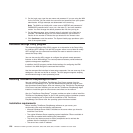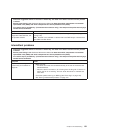The IMM supports the following basic system management features:
v Environmental monitor with fan speed control for temperature, voltages, fan
failure, power supply failure, and power backplane failure.
v LED indicators to report errors that occur with fans, power supplies,
microprocessor, hard disk drives, and system errors
v DIMM error assistance. The Unified Extensible Firmware Interface (UEFI) will
disable a failing DIMM that is detected during POST IMM will light the associated
system-error LED and the failing DIMM error LED.
v System-event log (SEL)
v ROM-based IMM firmware flash (IMM firmware updates)
v Auto Boot Failure Recovery (ABR)
v A virtual media key which enables full system management support (remote
video, remote keyboard/mouse, and remote storage)
v Automatic microprocessor disable on failure restart in a two-microprocessor
configuration when one microprocessor signals an internal error
v NMI detection and reporting
v SMI handling
v Automatic Server Restart (ASR) when (1) POST is not complete or (2) the OS
hangs and the OS Watchdog Timer times-out. The IMM might be configured to
watch for OS Watchdog Timer and reboot the system after timeout, if the ASR
feature is enabled. Otherwise, IMM allows the administrator to generate an NMI
by pressing an NMI button on the system board for OS memory dump. ASR is
supported by IPMI.
v Intelligent Platform Management Interface (IPMI) Specification V 2.0 and
Intelligent Platform Management Bus (IPMB) support
v Invalid system configuration (CNFG) LED support
v Serial redirect
v Serial Over LAN (SOL)
v Query power supply input power
v PECI 2 support
v Power/Reset control (power-on, hard and soft shut down, hard and soft reset,
schedule power control)
v Alerts (in-band and out-of-band alerting, PET traps - IPMI style, SNMP, e-mail)
v Operating system failure blue screen capture
v Command line interface
v Configuration save and restore
v PCI configuration data
v Boot sequence manipulation
The IMM also provides the following remote server management capabilities:
v Command-line interface (IPMI Shell)
The command-line interface provides direct access to server management
functions through the IPMI 2.0 protocol. Use the command-line interface to issue
commands to control the server power, view system information, and identify the
server. You can also save one or more commands as a text file and run the file
as a script.
v Serial over LAN
Establish a Serial over LAN (SOL) connection to manage servers from a remote
location. You can remotely view and change the UEFI settings, restart the server,
124 ThinkServer TS200 Types 6522, 6523, 6524, 6525, 6526, 6528, 6529, and 6530: Installation and User Guide


















